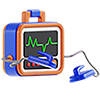Defibrillator Inventor – Who?
Defibrillators are widely used and easily accessible. They remain the most effective treatment for ventricular fibrillation.
You might wonder though: who discovered that shocking the human heart could be a good thing?
In this article, we explain the earliest defibrillators and the people behind them.
A Century in the Making
 To trace the origins of the defibrillator, we must go back more than 100 years, to the late 19th century, when electricity became commercially available.
To trace the origins of the defibrillator, we must go back more than 100 years, to the late 19th century, when electricity became commercially available.
The effects of electricity on the body were not initially understood. Accidents and deaths from electrocution occurred, yet scientists could not determine precisely why these shocks were deadly.
This resulted in experimentation with electricity on animals. One such experiment, at the University of Geneva in Switzerland in 1899 offered groundbreaking results.
Physiologists Jean-Louis Prevost and Frederic Batelli discovered that by using electricity, ventricular fibrillation could be induced in animals. They also found that by applying a greater current, they could restore the animal’s heart to a normal rhythm.
The results were both inconsistent and unexplainable at the time. Furthermore, it was believed that ventricular fibrillation was limited to animals.
This led to the first instance of internal defibrillation passing unnoticed.
First Defibrillation on a Human
It wasn’t until 1947 that defibrillation was used on a person, by an American cardiac surgeon named Claude Beck. He had developed a defibrillator for use in his own experiments on animals. The device was used for internal defibrillation, directly on the subject’s heart.
When a patient he was operating on, a 14-year-old boy, suddenly suffered ventricular fibrillation, he decided in desperation to attempt to defibrillate using his research device.
The patient’s heart being already exposed, the surgeons massaged the heart to maintain circulation while a colleague retrieved the defibrillator.
This primitive defibrillator was a bulky box containing a transformer and resistor to regulate the voltage and current. The electrodes consisted of two metal spoons with insulated handles.
The defibrillation was a success, and the boy made a full recovery.
The External Defibrillator
Claude Beck was the first to perform internal defibrillation on a person, but it was the work and findings of William B. Kouwenhoven that had led him there.
Kouwenhoven was an American electrical engineer who demonstrated electricity could both cause and reverse ventricular fibrillation.
Following these findings, he built the first true defibrillator designed for external use on a person. A large device mounted on a wheeled cart, it weighed roughly 200 pounds.
In 1957 at the John Hopkins Hospital, his defibrillator was used for the first time on a patient. The patient’s heart returned to a normal rhythm, marking a first in the field of emergency medicine.
Becoming More Portable
 The first defibrillation was a milestone in emergency treatment. But defibrillators were still bulky machines lacking in portability; they were all mains powered and located within hospitals.
The first defibrillation was a milestone in emergency treatment. But defibrillators were still bulky machines lacking in portability; they were all mains powered and located within hospitals.
It was in the 1960s when an Irish cardiologist named James Francis Partridge put forth an idea for more effective defibrillation.
He explained that since many cardiac deaths occurred outside of hospitals, it would be good practice to make defibrillators as accessible as possible and thus as portable as possible.
His first portable defibrillator was built in 1965 inside an ambulance. The defibrillator weighed 150 pounds and was operated using car batteries. By 1968, he managed to create a device weighing barely 6.5 pounds.
Portability was not Partridge’s only aim. He believed that a defibrillator could be used by people with little to no training, similar to a fire extinguisher. His vision of portability and ease of use led to the creation of the Automatic External Defibrillator (AED).
AED Devices are highly portable defibrillators, carried by emergency services and found in some workplaces and public areas. They work autonomously and can be operated by untrained lay persons.
The Implantable Defibrillators
Michel Mirowski, a Polish physician, took the idea of portable defibrillators even further. In the late 1960s, he suggested it could be possible to implant a defibrillator device within the body.
Defibrillator portability was still in its infancy. But Mirowski and his team persevered and in 1980, the first Implantable Cardioverter-Defibrillator (ICD) was installed in a patient.
Defibrillator Inventor – The Wrap Up
While William B. Kouwenhoven was the inventor of the external defibrillator, many other people have contributed over the years to defibrillator technology.
Their efforts have helped save the lives of countless people and improved the quality of life for many others.
Modern defibrillators have come a long way since the first devices, but the effort to create even more portable, effective, and easy-to-use defibrillators continues.
